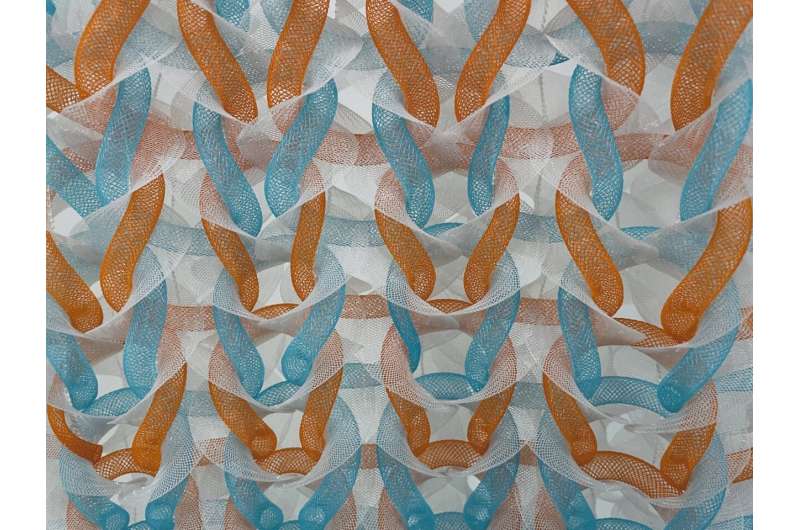This article has been reviewed according to Science X's editorial process and policies. Editors have highlighted the following attributes while ensuring the content's credibility:
fact-checked
trusted source
proofread
Q&A: How combining origami techniques with modern textile science can lead to practical applications

Exploring the frontiers of textile design, Randall Kamien of the School of Arts & Sciences at the University of Pennsylvania and long-time collaborator Geneviève Dion, a professor of design at Drexel University, are investigating the mechanics of knitting, an area of research that represents a significant shift in understanding and using fabrics.
In a Q&A with Penn Today, Kamien—the Vicki and William Abrams Professor in the Natural Sciences in the Department of Physics & Astronomy—and Dion discuss the origins, collaborations, and future implications of this approach, known as non-isometric origami. Their perspectives shed light on how combining traditional origami techniques with modern textile science can lead to practical applications in various industries.
What is non-isometric origami, and what initially inspired you to explore it in textile design?
Kamien: Origami and its close cousin kirigami have moved from art forms to tools used in engineering and design. The mechanical strength of the folded, cut, and pasted device or structure relies on the inability of the material to stretch.
Anyone who has used paper, the prototypical material for origami, knows this. Paper can easily be folded along creases, but it is nearly impossible to stretch it without tearing it. It is why smoothly wrapping an orange is so difficult compared to wrapping a box.
In our case, 'isometric' means distorting the material so that it is not stretched; the distances are all the same, the same metric. Knit material, on the other hand, is very stretchy and we rely upon its stretchability every time we put a sweater on over our head.
In fact, the ribs that pull together the cuffs on sleeves and the tops of socks are not created by using less yarn or less fabric; they are created through the geometry of the stitches, constrained by the topology of the yarn. How do we manipulate the stitches, like knit and purl, to get the fabric to stretch and fold by itself? Not only is it stretchy, non-isometric, but it is also self-folding.
How did you become acquainted with Geneviève Dion and her work? And could you explain how your seemingly disparate academic backgrounds come together to produce work like this?
Kamien: Ten years ago, we were introduced to each other by Charlie Epstein, an emeritus professor at Penn who knew Geneviève socially. It took us several years before we learned enough about each other's work to be able to communicate effectively. We had a breakthrough five years ago when we developed the idea of a "knitting scaffold," which captured the mechanics of knit fabric using tools from geometry.
This led us to more serious interactions and I became a regular visitor to her lab at Drexel. We now have joint postdocs and students with expertise in math, mechanical engineering, materials science, and theoretical physics.
What are some potential practical applications of non-isometric origami in everyday life?
Dion: Knitting fabric is obviously part of the multitrillion dollar fashion industry, but we want to involve much more than that. Not only do we want to be able to design self-folding fabric using only computers, a lot like the way they now design airplanes and cars, but we also want to develop the tools and protocols to use fabric as an integral part of all manufacturing.
It is additive like three-dimensional printing, is already done en masse by machine, and could be used to make flexible yet sturdy joints. Can you imagine an airplane where the control surfaces are knit onto the wing, providing many more degrees of freedom than typical hinges, and which can be replaced by using an onboard knitting machine?
Where do you see the future of textile design heading with advancements like non-isometric origami?
Kamien: Aside from building materials, since the non-isometric origami is also self-folding, we can envisage a new set of materials that can be rolled up onto spools and then unfurled, whereupon they will pop up into useful structures without an internal skeleton.
You've recently received support from the Charles E. Kaufman Foundation for further research in this space. How will this be helpful for you and your collaborators?
Kamien: Up until now our collaboration, for the most part, has been geared towards application to 'functional fabric." The Kaufman Foundation support will allow us to dive deeply into the mechanics of knit fabrics. We have some concrete plans on how to use the theory of block copolymers to model this material and some less-baked ideas about using the intrinsic geometry of the fibers and the scaffold to develop a theoretical framework that would allow us to understand flexible, stretchable sheets of any material.
How do you envision collaborating with industries or other sectors to bring the benefits of your research to a broader audience?
Dion: Though knit materials are exquisitely tunable and functional structures, their full potential has yet to be realized. Our fundamental research will move design decisions beyond 'guess and check' to a systematic, top-down set of principles.
By demonstrating our ability to engineer and predict the geometry and behavior of knit structures, we hope to add knit materials to the toolbox of mechanical engineering and design.



















